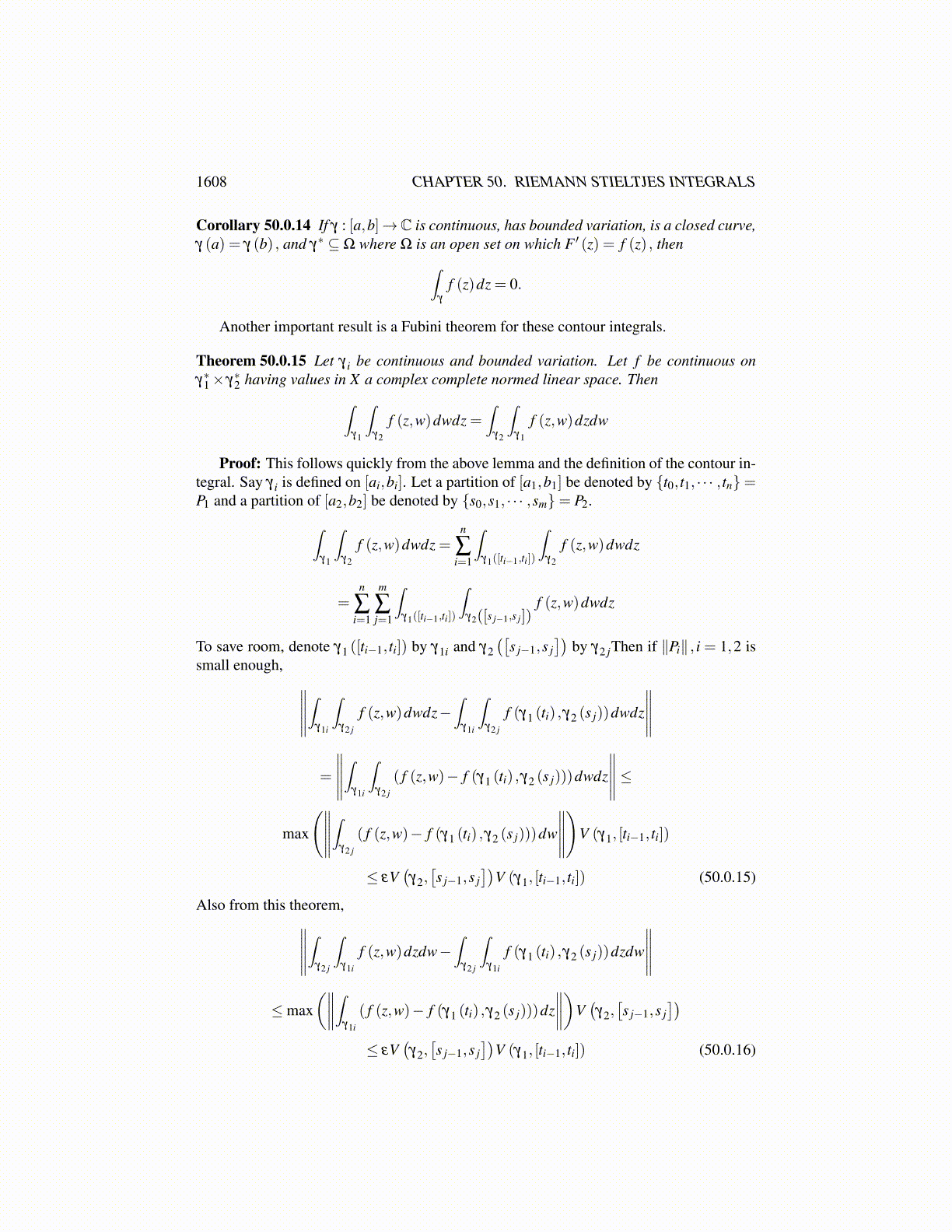
1608 CHAPTER 50. RIEMANN STIELTJES INTEGRALS
where here
X[a,b] (s)≡{
1 if s ∈ [p,q]0 if s /∈ [p,q] .
Also, ∫ b
af (γ (s))γ
′ (s)ds =∫ b
a
n
∑j=1
f (γ (s))X[t j−1,t j ] (s)γ′ (s)ds
and thanks to 50.0.13,∣∣∣∣∣∣∣∣∣∣
∣∣∣∣∣∣∣∣∣∣
=∑nj=1 f(γ(τ j))(γ(t j)−γ(t j−1))︷ ︸︸ ︷∫ b
a
n
∑j=1
f (γ (τ j))X[t j−1,t j ] (s)γ′ (s)ds−
=∫ b
a f (γ(s))γ ′(s)ds︷ ︸︸ ︷∫ b
a
n
∑j=1
f (γ (s))X[t j−1,t j ] (s)γ′ (s)ds
∣∣∣∣∣∣∣∣∣∣
∣∣∣∣∣∣∣∣∣∣≤
n
∑j=1
∫ t j
t j−1
∣∣∣∣ f (γ (τ j))− f (γ (s))∣∣∣∣ ∣∣γ ′ (s)∣∣ds≤
∣∣∣∣γ ′∣∣∣∣∞ ∑
jε(t j− t j−1
)= ε
∣∣∣∣γ ′∣∣∣∣∞(b−a) .
It follows that∣∣∣∣∣∣∣∣∫γ
f dγ−∫ b
af (γ (s))γ
′ (s)ds∣∣∣∣∣∣∣∣≤
∣∣∣∣∣∣∣∣∣∣∫
γ
f dγ−n
∑j=1
f (γ (τ j))(γ (t j)− γ
(t j−1
))∣∣∣∣∣∣∣∣∣∣
+
∣∣∣∣∣∣∣∣∣∣ n
∑j=1
f (γ (τ j))(γ (t j)− γ
(t j−1
))−∫ b
af (γ (s))γ
′ (s)ds
∣∣∣∣∣∣∣∣∣∣≤ ε
∣∣∣∣γ ′∣∣∣∣∞(b−a)+ ε.
Since ε is arbitrary, this verifies 50.0.12.
Definition 50.0.10 Let Ω be an open subset of C and let γ : [a,b]→ Ω be a continuousfunction with bounded variation f : Ω→ X be a continuous function. Then the followingnotation is more customary. ∫
γ
f (z)dz≡∫
γ
f dγ.
The expression,∫
γf (z)dz, is called a contour integral and γ is referred to as the contour.
A function f : Ω→ X for Ω an open set in C has a primitive if there exists a function, F, theprimitive, such that F ′ (z) = f (z) . Thus F is just an antiderivative. Also if γk : [ak,bk]→Cis continuous and of bounded variation, for k = 1, · · · ,m and γk (bk) = γk+1 (ak) , define∫
∑mk=1 γk
f (z)dz≡m
∑k=1
∫γk
f (z)dz. (50.0.14)
In addition to this, for γ : [a,b]→ C,define −γ : [a,b]→ C by −γ (t) ≡ γ (b+a− t) . Thus γ simply traces out the points of
γ∗ in the opposite order.